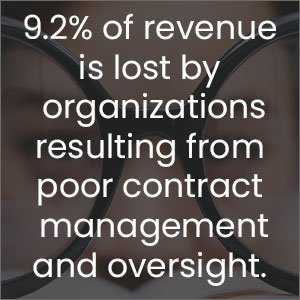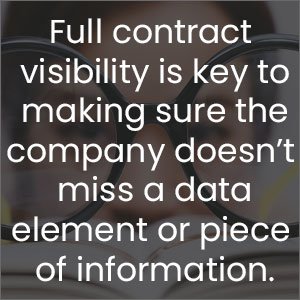Recent research by the IACCM shows that in the banking, financial, and insurance industries, only 32% of respondents have a post-award contract management system. Although the research is specific to these three industries, I would speculate that other industries show similar if not less compelling figures. This leads us to ask how important contract visibility is to mid and large-sized businesses.
BUSINESSES = CONTRACTS
Businesses are all run on contracts. You just cannot get around it. There is no avoiding it. But, it is all for good reason. Good business practices are about agreements. More importantly, it is about agreements that are documented. These agreements make sure that all parties are clear about the terms, transactions, commitments, obligations, and other associated agreement attributes. In essence, the contract is the source of truth about a specific business accord.
Consider the following: 
- The average Fortune 1000 company has between 20,000 and 40,000 active contracts
- 9.2% of revenue is lost by organizations resulting from poor contract management and oversight (IACCM)
Facing these figures, it is hard to argue that contract management solutions aren’t important. Specifically, these notables point out how contract visibility is a very important element to the contracting officer, and the company overall.
CONTRACTS DESERVE RESPECT
Another interesting perspective about contracts is their cost. In a recent post on the cost of contracts, we showed a summary of the IACCM research from late 2018. Multiple sources throughout the contract management membership offered their estimations for the study. Currently, the average cost of contract estimates are:
- $6,900 USD for low risk/complexity
- $21,300 USD for medium complexity
- $49,000 USD for high complexity contracts
Developing an agreement takes considerable time and effort. Of course, it is important to start a relationship with a common understanding of both parties. However, it is equally important that the organization keeps these records maintained, and review them for consistency, and adherence. It certainly makes no sense that a contract that may have cost $49,000 or more, is lost or misfiled. Not only is the cost of the effort lost, but the implications to the company would be significantly greater than merely the cost of the contract process.
FILE CABINETS TO CONTRACT SYSTEM OF RECORD
It is clear that contract documents are the lifeblood of keeping a company in business. So, having full contract visibility is key to making sure the company does not miss a key data element or piece of information. For example, missing a lease renewal by even a day or two can cost millions of dollars for a mid-large corporation. Full contract visibility is key to making sure the company doesn’t miss a data element or piece of information.
First of all, have a centralized contract repository for all your contracts to ensure they don’t get lost. You don’t want to be among the 10%. Then, having a contract lifecycle management (CLM) system makes extracting key information easier and faster. A CLM with a natural language processing (NLP) artificial intelligence (AI), accelerates key information retrieval. It also applies intelligence to identifying risks, aberrations, and flagging non-standard language. All this with speed. In today’s business world, real-time access to information in thousands of contracts can mean the difference between intelligent business decisions, and those we prefer to forget.
Creating a standardized system of record is about having all your contracts in one place. It is about creating one single authoritative data source. This lets your company create sound management processes. Now you can convert your contracting team from ‘a cost of doing business,’ to a resource ‘extracting business value’ from assets you already have.
CONTRACT VISIBILITY – IMPORTANT OR NOT?
Roughly 50% – 60% of mid to large companies are tracking contracts manually, on a word document, or excel spreadsheet – we know there is a problem. The challenge is the lack of instant contract visibility, to quickly scan from one to the next. Another is the lack of an intelligent system to spot similarities, differences, risks, costs, and map out the timing of trigger events.
The future of contracts is digital systems that provide a clear and quick view of the full breadth of your company’s contracts. Consistent and fast visibility with insights gives the executive suite the opportunity to make decisions based on facts, rather than rough estimations. The future of contracts consists of making them a true business-enhancing value, rather than merely a series of constraints, obligations, and commitments.
So, is contract visibility important? Without a doubt – yes.



